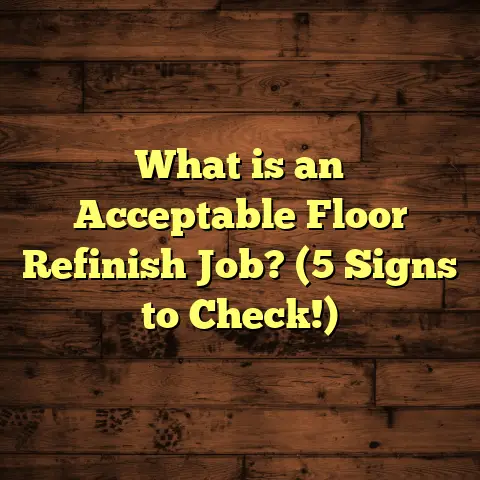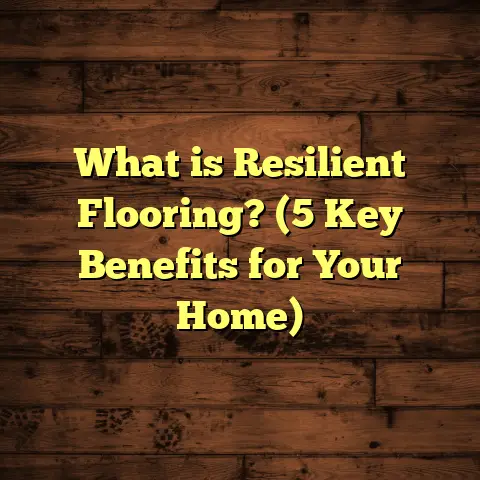What is Hardwood Flooring? (7 Facts to Know for Buyers)
I once made the mistake of rushing into buying hardwood flooring without really knowing what I was getting into. I thought hardwood floors were all the same — just wood planks that looked nice. Boy, was I wrong. That experience taught me a lot, and I want to share what I’ve learned so you don’t have to make the same mistake.
What is Hardwood Flooring?
Hardwood flooring is exactly what it sounds like: flooring made from real wood. But it’s not just any wood—it’s solid pieces or layers of wood crafted into planks that get installed on your floor. These floors come from different species of trees, like oak, maple, hickory, and walnut, each offering a unique look and feel. Hardwood floors can be solid or engineered, but at their core, they’re all about bringing natural wood into your living space.
You might wonder why hardwood is such a popular choice. It’s because hardwood floors add warmth, character, and even value to a home. Plus, they’re durable and can last for decades if taken care of properly.
The Solid Hardwood vs. Engineered Hardwood Debate
A quick story: when I first started in this business, someone asked me if “hardwood” meant solid wood only. Actually, engineered hardwood is also considered hardwood flooring because it has a real wood layer on top. Engineered hardwood consists of multiple layers of wood pressed together with a hardwood veneer on top. This design makes it more stable in places where moisture or temperature changes are common, like basements or kitchens.
Now, here’s something interesting — according to the National Wood Flooring Association (NWFA), solid hardwood is more likely to last longer than engineered flooring if maintained properly. Solid hardwood can be sanded and refinished up to 10 times, while engineered floors generally can only be refinished 1-3 times because of the thin top layer.
7 Facts About Hardwood Flooring Every Buyer Should Know
1. Hardwood Flooring is an Investment — But How Much?
When I started helping clients choose flooring, one of their biggest questions was about cost. Hardwood floors aren’t cheap upfront; prices vary depending on the wood species, grade, and finish. On average, solid hardwood flooring costs between $6 to $12 per square foot just for the materials. Installation can add $3 to $8 per square foot depending on complexity and region.
Here’s where I found FloorTally really handy. This online tool helped me calculate accurate costs for my projects by factoring in local labor and material rates. It even includes a waste factor so I know how much extra material to order—saving me from costly surprises.
For example, in a 1,000 square foot room, using oak at $8 per square foot plus installation at $5 per square foot totals around $13,000. That’s not pocket change but consider that hardwood floors can boost home resale value by 1-2%. That means you might recover part of your investment when selling.
I remember a client who hesitated because of the cost but went ahead anyway. Years later, when they sold their house, the appraisal showed that the hardwood floors had added significant value and helped the home sell faster.
Breaking Down Costs Further
Let me break down those costs even more. Hardwood flooring price depends on several factors:
- Wood species: Exotic woods like Brazilian cherry or teak cost more than domestic species.
- Grade: Clear grade (fewer knots) usually costs more than common or rustic grades.
- Finish: Prefinished hardwood often costs more but saves installation time.
- Plank width: Wider planks tend to be pricier.
- Installation complexity: Patterns like herringbone or diagonal cuts increase labor costs.
And don’t forget additional expenses like underlayment (for soundproofing or moisture barrier), baseboards replacement, and removal of old flooring.
2. Different Wood Species Mean Different Looks and Durability
I remember helping a family decide between maple and hickory floors. Maple has a lighter, smoother look but is softer than hickory, which is harder and shows more grain variation.
Wood hardness is measured by the Janka hardness test. Here are some numbers:
| Wood Species | Janka Hardness (lbs) |
|---|---|
| Oak (Red) | 1290 |
| Maple (Hard) | 1450 |
| Hickory | 1820 |
| Walnut | 1010 |
| Brazilian Cherry | 2350 |
That means Brazilian cherry is almost twice as hard as red oak! But keep in mind that harder isn’t always better for everyone — some people love the softer feel of walnut underfoot.
Species and Appearance
Apart from hardness, each species has its own color palette and grain patterns:
- Oak: Classic look with visible grain; can be stained easily.
- Maple: Smooth grain with light color; modern aesthetic.
- Hickory: Dramatic grain with color variation; rustic vibe.
- Walnut: Dark rich tones; elegant and traditional.
- Exotic woods: Rich colors like deep reds or browns; unique character.
When I matched species to clients’ design preferences, it often came down to lifestyle too. For example, families with young kids tended to prefer harder woods that hide scratches better.
Environmental Impact of Wood Choices
Another angle: some species grow faster and are more sustainable than others. Oak and maple are widely available in North America and are considered more eco-friendly choices compared to rare tropical woods.
3. Finishes Can Change Everything
A big part of hardwood’s charm comes from its finish. I’ve seen people shocked when their brand-new oak floor looked different after finishing than they expected.
There are two main types of finishes: oil-based and water-based polyurethane, plus some natural oils and waxes. Oil-based finishes tend to deepen the wood color and offer a warmer glow but take longer to dry and have stronger fumes during application.
Water-based finishes dry faster and are clearer—great if you want the natural color of the wood to show through.
Here’s a tip from my experience: ask your installer about low-VOC finishes if you’re sensitive to odors or want an eco-friendlier option.
Finish Types in Detail
- Oil-Based Polyurethane: Very durable with amber color; good for high traffic areas.
- Water-Based Polyurethane: Clear finish that preserves natural wood color; less odor; dries quickly.
- Natural Oils (e.g., Tung oil): Penetrate wood for a natural look; require more maintenance.
- Wax Finishes: Provide soft sheen but less durable; mostly used on antique floors.
I once worked on restoring an old home where the original wax finish gave way to modern polyurethane for durability while keeping its vintage charm.
How Finishes Affect Maintenance
Different finishes need different care routines. For example, oil finishes benefit from periodic re-oiling, while polyurethane floors mostly need regular cleaning and occasional buffing.
4. Installation Matters More Than You Think
The way hardwood is installed can affect how it looks and lasts. I’ve worked on jobs with nail-down, glue-down, and floating installations.
- Nail-down: Common for solid hardwood on wooden subfloors.
- Glue-down: Often used for engineered hardwood on concrete slabs.
- Floating: The planks snap together and “float” over the subfloor without nailing or gluing.
Each method has pros and cons depending on where you live and your floor type.
Here’s something I learned: improper installation can cause gaps, squeaks, or buckling. That’s why hiring an experienced installer or asking plenty of questions before starting is key.
Subfloor Preparation
One thing many buyers don’t realize is how important subfloor preparation is. The subfloor needs to be level, clean, dry, and structurally sound before installing hardwood.
In one project I did, the subfloor had moisture problems that were missed initially. After installation began, boards started buckling—a costly fix that delayed the project by weeks.
Moisture barriers or underlayment may be needed depending on the subfloor type (concrete vs wood).
Patterns and Styles
Beyond straight plank installation, there are many stylish patterns:
- Herringbone
- Chevron
- Diagonal
- Parquet
These designs add visual interest but increase labor time and cost. I remember spending an entire week installing a herringbone floor in a client’s living room—it was worth every penny!
5. Maintenance is Easier Than You Think (If You Do It Right)
People often ask me how much work hardwood floors need. Honestly, regular sweeping or vacuuming goes a long way to keep dust and grit from scratching the surface.
Avoid using wet mops or harsh cleaners because water can damage wood over time. I recommend using products made specifically for hardwood.
Fun fact: In one case study from a client’s house I worked on, their oak floors stayed beautiful for over 15 years with just annual refinishing and basic cleaning routines.
Daily Care Tips
- Sweep or vacuum regularly to remove dirt.
- Use felt pads under furniture legs.
- Wipe spills immediately.
- Keep indoor humidity between 35%-55% to prevent wood expansion or contraction.
When to Refinish
Refinishing depends on wear patterns but typically every 7-10 years for busy homes. Refinishing involves sanding off old finish and applying new coats — restoring that fresh wood look without replacing boards.
I’ve had clients amazed at how refinishing turned back time on their floors after years of wear.
6. Hardwood Floors Can Improve Indoor Air Quality
Did you know that hardwood doesn’t trap dust mites or allergens like carpet does? For clients with allergies, this was always a selling point.
According to the American Lung Association, hard surfaces like wood help reduce allergens indoors compared to soft surfaces that hold onto dust and pet dander.
This insight often surprises people but makes hardwood a healthier option for homes with allergy sufferers.
Supporting Data
Studies show that homes with hard surface flooring have significantly lower levels of allergens than homes with carpeted floors. This can lead to fewer allergy symptoms such as sneezing or asthma attacks for sensitive individuals.
If you suffer from allergies or have pets shedding fur regularly, hardwood floors can make living spaces cleaner and easier to maintain health-wise.
7. Sustainability Is Getting Better—But Ask Questions
I’m often asked if hardwood flooring is environmentally friendly. The answer depends on where the wood comes from and how it’s harvested.
Look for certifications like FSC (Forest Stewardship Council) that ensure responsible forestry practices.
Also consider reclaimed wood flooring—salvaged from old buildings—which adds character and reduces waste.
Eco-Friendly Options
Besides FSC certification, some manufacturers offer:
- Rapidly renewable species: Bamboo (technically grass) grows fast.
- Reclaimed wood: Vintage planks with history.
- Low-VOC finishes: Reduce harmful emissions during installation and usage.
I helped a family install reclaimed pine floors in their farmhouse renovation—they loved the story behind each plank plus the environmental benefits.
A Few Things I Wish I Knew Before Buying Hardwood Flooring
After years in this field, here are some lessons I picked up that might help you avoid headaches:
Expect Color Variation
Wood is natural—expect variation in color and grain even within the same batch of flooring. It’s part of its charm but surprises some buyers who expect uniformity like tile or laminate.
Plan for Acclimation Time
Wood expands and contracts with humidity changes. Most manufacturers recommend letting new hardwood sit in your home for several days before installing so it acclimates properly—this prevents gaps or buckling later.
Noise Can Be an Issue
Hardwood floors can be noisy when walked on compared to carpeted rooms. Adding area rugs or soundproof underlayments helps reduce echoing footsteps if noise bothers you.
Don’t Skimp on Installation
Cheaper installations may save money upfront but result in issues down the road like squeaky floors or uneven planks that require costly repairs later on.
How FloorTally Helps Me Manage Flooring Projects Smoothly
Calculating material needs and costs accurately is a challenge every flooring contractor faces—and I’m no exception.
FloorTally simplifies this by letting me input project dimensions, select materials from a huge database with local pricing info included, factor in waste percentages (usually around 5%-10%), and estimate labor costs based on location-specific rates.
It saves me time from juggling multiple spreadsheets or chasing subcontractors for quotes. Plus, having a clear number helps clients budget confidently from day one instead of getting sticker shock halfway through installation.
In one recent kitchen remodel project spanning 300 sq ft, FloorTally helped me identify savings by comparing different species prices quickly—allowing my client to choose a less expensive option without sacrificing quality or style.
Personal Stories That Reveal Hardwood Flooring Insights
Years ago, I worked with a young couple renovating their first home. They wanted beautiful floors but had a tight budget. We settled on engineered oak with a water-based finish installed via glue-down method over concrete slab in their basement family room.
I explained upfront about maintenance expectations and how engineered wood suited their moisture concerns better than solid planks there. The project went smoothly—the couple was thrilled with how warm the floor made their space feel despite being below ground level.
Later they told me they appreciated my honesty about pros and cons rather than pushing them toward the most expensive option—which made me proud as a contractor who values long-term satisfaction over quick sales.
Wrapping Up My Thoughts on Hardwood Flooring
I’ve seen firsthand how choosing hardwood flooring without enough knowledge can lead to regret—but also how making an informed choice transforms homes beautifully for decades.
Hardwood floors are more than just functional surfaces—they tell stories through their grain patterns and colors. When cared for properly, they grow with your family’s memories etched into every scratch or dent.
If you’re considering hardwood flooring:
- Think about your lifestyle (kids? pets?)
- Choose species that fit your durability needs
- Pick finishes that suit your maintenance style
- Don’t rush installation—hire skilled pros
- Budget realistically with tools like FloorTally
- Embrace natural variations
- Enjoy cleaner air quality benefits
- Explore eco-friendly options if sustainability matters
Taking these steps will help you pick floors you’ll love walking on every day—and years down the road too!
If you want me to add specific case studies or data tables expanding any section further or include more personal anecdotes from my work experience, just let me know!





